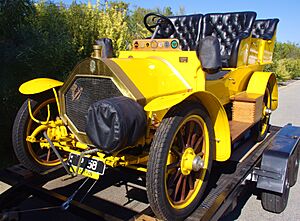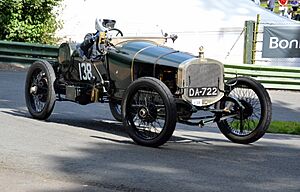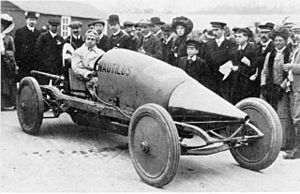Louis Coatalen facts for kids
Louis Hervé Coatalen (born September 11, 1879 – died May 23, 1962) was a brilliant car engineer and racing driver. He was born in Brittany, France, but spent most of his adult life in Britain and became a British citizen. He was a pioneer in designing and improving engines for cars and airplanes.
Contents
Early Life in France
Louis Coatalen was born in the fishing town of Concarneau in France. He was the second son of J Coatalen. He later studied engineering at Arts et Métiers ParisTech in Cluny, France.
Career in Engineering
After finishing his training with famous car companies like De Dion-Bouton, Clément, and Panhard et Levasseur, Louis moved to England in 1900. He worked briefly for the Crowden Motor Car Company before joining Humber Limited in 1901. He quickly became their chief engineer. He designed their successful 8-10 and 10-12 car models.
In 1906, when he was around 26 or 27, he teamed up with bicycle maker William Hillman. In 1908, he even drove their Hillman-Coatalen car in the Isle of Man Tourist Trophy race.
Joining Sunbeam
His partnership with Hillman ended in 1909. Coatalen then moved to Wolverhampton to join the Sunbeam company. By 1914, he became a joint managing director there.
Sunbeam 12-16 Car
Coatalen's first design at Sunbeam was the 12-16 car, which was considered one of the best light car designs of its time. In 1912, three 12-16 cars took the top three spots in a two-day race in Dieppe, France, for 3-liter cars. One of these cars also finished third in a Grand Prix race.
Grand Prix Victories
Sunbeam cars, under Coatalen's influence, won the Tourist Trophy races in 1914 and 1922. They also took the top three places in the 1923 French Grand Prix.
Designing Aero Engines
During World War I, Louis Coatalen designed aircraft engines for Sunbeam. After his death, Lord Sempill wrote that Coatalen was one of the three most important designers of engines for planes and airships used by the British Navy during the war. The other two were W O Bentley and Sir Henry Royce.
Sunbeam made more types of aero engines than any other company during the war. W.O. Bentley said this was partly because Coatalen was very good at convincing the Navy and War Office to use his ideas.
In 1920, Sunbeam joined with Clément-Talbot and Darracq to form STD Motors Limited. Coatalen became a director of STD Motors, but he remained the chief engineer for Sunbeam. Later, he was put in charge of all the technical and design teams for all the companies under STD.
Focus on Race Cars
As the 1.5-liter Talbot-Darracq cars became successful, Coatalen became very interested in racing cars. Sunbeam's wins helped them become a top name in international racing. They had legendary success, winning the 1912 Coupe de l’Auto, the 1914 and 1922 Tourist Trophy, and the 1923 and 1924 Grand Prix races. Coatalen worked with famous designer Ernest Henry on the 1922 Grand Prix Sunbeams. He also had some of the best drivers of the time, like Henry Segrave, Jean Chassagne, and Kenelm Lee Guinness, driving his Sunbeam cars.
In 1926, Sunbeam's racing activities moved to Suresnes, near Paris, France. Although Coatalen still worked part-time in Wolverhampton, he spent most of his time in Paris.
Under his guidance, Sunbeam was one of the first British car makers to include front-wheel brakes. Coatalen also introduced new ideas like balancing wheels and putting the oil pump inside the engine's oil pan. He was also an early supporter of using shock absorbers in cars.
Breaking Speed Records
Sunbeam became very involved in trying to break land speed records. This included the successful 1000HP car in 1927 and the 'Silver Bullet' car in 1930, which didn't succeed. Louis Coatalen designed the engines for the first car to go over 150 miles per hour and the first car to go over 200 miles per hour. This was the 1000 horsepower Sunbeam driven by Henry Segrave.
Life in France
After selling his shares in STD, Coatalen bought control of the French branch of Lockheed hydraulics. With the money from this, he bought a yacht and a villa on the Isle of Capri.
He lived in France during World War II and continued to live there until he passed away suddenly in Paris in 1962 at the age of 82.
A Motor Industry Leader
After Coatalen's death, Sunbeam expert Anthony S. Heal described him as an "impresario" of the motor industry. This means he was someone who organized and led big projects. Heal said, "He led and inspired others to achieve miracles they themselves would not have thought possible."
W.O. Bentley also described him as "not only a first class businessman... he had other qualities which I liked even better; he was highly educated and amusing and a tremendous raconteur, and he was dedicated to motor racing."
Images for kids








